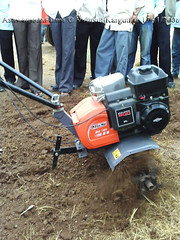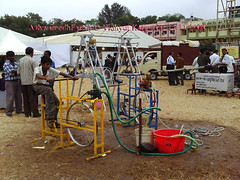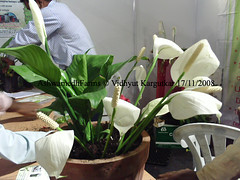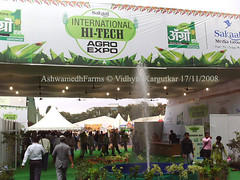I also saw this coconut twin plant on sale!
And if you believe this is weired see the link below!!! :o
http://coconutfreaks.blogspot.com/2006/01/multi-headed-coconut-palms.html
Tuesday, December 9, 2008
Ashwagandha
Withania somnifera, also known as Ashwagandha, Indian ginseng, Winter cherry, Ajagandha, Kanaje Hindi and Samm Al Ferakh, is a plant in Solanaceae or nightshade family.
The roots and berries of the plant are used in herbal medicine. It grows as a stout shrub that reaches a height of 170cm. It is commercially cultivated in Madhya Pradesh.
The main constituents of ashwagandha are alkaloids and steroidal lactones.
Ashwagandha in Sanskrit means "horse's smell", probably originating from the odor of its root which resembles that of sweaty horse.
The Ashwagandha plant has also become a target of patent seeking overseas firms as can be seen in this TOI report, please click on link:
http://www.hvk.org/articles/0501/69.html
The roots and berries of the plant are used in herbal medicine. It grows as a stout shrub that reaches a height of 170cm. It is commercially cultivated in Madhya Pradesh.
The main constituents of ashwagandha are alkaloids and steroidal lactones.
Ashwagandha in Sanskrit means "horse's smell", probably originating from the odor of its root which resembles that of sweaty horse.
The Ashwagandha plant has also become a target of patent seeking overseas firms as can be seen in this TOI report, please click on link:
http://www.hvk.org/articles/0501/69.html
Rudraksha plant
A rare sight to see nowadays was this "rudraksh" plant for sale (both round and elongated).
Each plant was for Rs. 500 only but i had spent my money on buying books hence i couldnt buy even a single one. :(
It so happens that people will spend money like crazy for buying beads but there arent many takers for conservation and propagation of the plant itself!
Unfortunately even i didnt take the name of the exhibitor who had on sale rare plants as well as our regular garden varieties.
Some Information on rudraksh plant:
Rudraksha is the name of the dark berries of Elaeocarpus ganitrus, used to make prayer beads. The word is a Sanskrit compound consisting of the name Rudra and ākṣa meaning eye. Latin name 'ganitrus' possibly taken from ganitri, the name for this species in Sundanese and Malay.
The Rudraksha is a large evergreen broad-leaved tree that grows in the area from the Gangetic plain to the foothills of the Himalayas. Rudraksha trees are also found in middle areas of Nepal. Rudraksha seeds are covered by an outer shell of blue color when fully ripe, and for this reason are also known as blueberry beads. The blue colour is derived not from pigment but is structural.
A report by I.I.S.C. on the dwindling numbers of rudraksha tress and rampant felling and collection of seeds leading to loss of rudraksha trees across India. File is in *pdf format, you will need acrobat for viewing.
http://www.iisc.ernet.in/currsci/mar102004/646.pdf
Pictures of Rudraksha:
http://toptropicals.com/pics/garden/07/479/P5124750.jpg
http://toptropicals.com/pics/garden/07/479/P5124752.jpg
http://toptropicals.com/pics/garden/07/479/P5124753.jpg
On Flickr
http://www.flickr.com/photos/laughingbuddhaz/2988944154/
Each plant was for Rs. 500 only but i had spent my money on buying books hence i couldnt buy even a single one. :(
It so happens that people will spend money like crazy for buying beads but there arent many takers for conservation and propagation of the plant itself!
Unfortunately even i didnt take the name of the exhibitor who had on sale rare plants as well as our regular garden varieties.
Some Information on rudraksh plant:
Rudraksha is the name of the dark berries of Elaeocarpus ganitrus, used to make prayer beads. The word is a Sanskrit compound consisting of the name Rudra and ākṣa meaning eye. Latin name 'ganitrus' possibly taken from ganitri, the name for this species in Sundanese and Malay.
The Rudraksha is a large evergreen broad-leaved tree that grows in the area from the Gangetic plain to the foothills of the Himalayas. Rudraksha trees are also found in middle areas of Nepal. Rudraksha seeds are covered by an outer shell of blue color when fully ripe, and for this reason are also known as blueberry beads. The blue colour is derived not from pigment but is structural.
The berries show variation in the number of grooves on their surface, and are classified on the basis of the number of divisions that they have. A common type has five divisions, and these are considered to be symbolic of the five faces of Shiva.
The Rudraksh seeds are brittle in nature and so should be protected from chemicals.
The best way to find the authenticity of a rudraksha is to get it X-rayed and count the number of compartments inside. If they are equal to the number of lines outside the rudraksha is real.
Rudraksh is also used by people as a rosary while chanting mantras.A report by I.I.S.C. on the dwindling numbers of rudraksha tress and rampant felling and collection of seeds leading to loss of rudraksha trees across India. File is in *pdf format, you will need acrobat for viewing.
http://www.iisc.ernet.in/currsci/mar102004/646.pdf
Pictures of Rudraksha:
http://toptropicals.com/pics/garden/07/479/P5124750.jpg
http://toptropicals.com/pics/garden/07/479/P5124752.jpg
http://toptropicals.com/pics/garden/07/479/P5124753.jpg
On Flickr
http://www.flickr.com/photos/laughingbuddhaz/2988944154/
Rotary Tiller
Rotary tiller is also known as rototiller & rotavator.
Rotating tines or blades turn the soil around.
To keep the machine from moving forward too fast, an adjustable tine is fixed just behind the blades so that through friction with deeper un-tilled soil, it acts as a brake, slowing the machine and allowing it to pulverize the soils. The slower a rototiller moves forward, the more soil tilth can be obtained.
Rototilling is much faster than manual tilling, but notoriously difficult to handle and exhausting work, especially in the heavier and higher horse power models. If the rototiller's blades catch on unseen sub-surface objects, such as tree roots and buried garbage, it can cause the rototiller to abruptly and violently move in any direction.
Rotating tines or blades turn the soil around.
To keep the machine from moving forward too fast, an adjustable tine is fixed just behind the blades so that through friction with deeper un-tilled soil, it acts as a brake, slowing the machine and allowing it to pulverize the soils. The slower a rototiller moves forward, the more soil tilth can be obtained.
Rototilling is much faster than manual tilling, but notoriously difficult to handle and exhausting work, especially in the heavier and higher horse power models. If the rototiller's blades catch on unseen sub-surface objects, such as tree roots and buried garbage, it can cause the rototiller to abruptly and violently move in any direction.
Cycle operated water-lifting pump
Cycle operated water-lifting pump
While i was exploring the grounds, i also saw the greatly innovative "cycle operated water-lifting pump".
A little boy was operating it effortlessly!
The pump has been invented by Vikram Rathore, a small tribal farmer from Narsapur village, Utnoor Mandal, Adilabad in Andhra Pradesh.
For this iinovation he has also won an award from the National Innovation Foundation.
"This is a centrifugal water pump which is run by rotating the pedal of a cycle. The system comprises a bicycle, rim, beltpulley, impeller and inlet and delivery pipes. A bare rim replaces the rear wheel of the bicycle. The rim is connected to another pulley with a smaller diameter. The supporting shaft of the smaller pulley carries another rim for second stage speed increment. The shaft also carries a flywheel to increase momentum of the system. The final supporting shaft is connected with an impeller that rotates at high speed and pumps water. The power (energy) generated through this process of pedaling is used to lift the water and push the water from a pipe into the farm for cultivation. This innovation is useful for pumping water from rivers, ponds, wells and similar water sources thus enabling poor farmers for pumping water for irrigation and cultivation."
As described on N.I.F. site. Kindly visit their website:
http://www.nif.org.in/Cycle_operated_water-lifting_pump
While i was exploring the grounds, i also saw the greatly innovative "cycle operated water-lifting pump".
A little boy was operating it effortlessly!
The pump has been invented by Vikram Rathore, a small tribal farmer from Narsapur village, Utnoor Mandal, Adilabad in Andhra Pradesh.
For this iinovation he has also won an award from the National Innovation Foundation.
"This is a centrifugal water pump which is run by rotating the pedal of a cycle. The system comprises a bicycle, rim, beltpulley, impeller and inlet and delivery pipes. A bare rim replaces the rear wheel of the bicycle. The rim is connected to another pulley with a smaller diameter. The supporting shaft of the smaller pulley carries another rim for second stage speed increment. The shaft also carries a flywheel to increase momentum of the system. The final supporting shaft is connected with an impeller that rotates at high speed and pumps water. The power (energy) generated through this process of pedaling is used to lift the water and push the water from a pipe into the farm for cultivation. This innovation is useful for pumping water from rivers, ponds, wells and similar water sources thus enabling poor farmers for pumping water for irrigation and cultivation."
As described on N.I.F. site. Kindly visit their website:
http://www.nif.org.in/Cycle_operated_water-lifting_pump
Anthurium
Anthurium is a large genus of about 600- 800 species. It belongs to the arum family (Araceae). Anthurium is also called "Flamingo Flower" or "Boy Flower", both referring to the structure of the spathe and spadix.
The species has neotropical distribution; mostly in wet tropical mountain forest of Central America and South America, but some in semi-arid environments. Most species occur in Panama, Colombia, Brazil, the Guiana Shield and Ecuador. According to the work of noted aroid botanist Dr. Tom Croat of the Missouri Botanical Garden, this genus is not found in Asia. Some species have been introduced into Asian rain forests, but are not endemic.
Anthurium grows in many forms, mostly evergreen, bushy or climbing epiphytes with roots that can hang from the canopy all the way to the floor of the rain forest. There are also many terrestrial forms which are found as understory plants, as well as hemiepiphytic forms. A hemiepiphyte is a plant capable of beginning life as a seed and sending roots to the soil, or beginning as a terrestrial plant that climbs a tree and then sends roots back to the soil. They occur also as lithophytes. Some are only found in association with arboreal ant colonies or growing on rocks in midstream (such as Anthurium amnicola).
The species has neotropical distribution; mostly in wet tropical mountain forest of Central America and South America, but some in semi-arid environments. Most species occur in Panama, Colombia, Brazil, the Guiana Shield and Ecuador. According to the work of noted aroid botanist Dr. Tom Croat of the Missouri Botanical Garden, this genus is not found in Asia. Some species have been introduced into Asian rain forests, but are not endemic.
Anthurium grows in many forms, mostly evergreen, bushy or climbing epiphytes with roots that can hang from the canopy all the way to the floor of the rain forest. There are also many terrestrial forms which are found as understory plants, as well as hemiepiphytic forms. A hemiepiphyte is a plant capable of beginning life as a seed and sending roots to the soil, or beginning as a terrestrial plant that climbs a tree and then sends roots back to the soil. They occur also as lithophytes. Some are only found in association with arboreal ant colonies or growing on rocks in midstream (such as Anthurium amnicola).
Monday, December 8, 2008
Focus on Floriculture
This year there was special emphasis on floriculture. There were many stalls promoting growing of flowers as the current populist agro produce.
International High-Tech Agro Expo, Pune 2008
International HI-TECH Agro Expo 2008, from 13-17 November 2008 at College of Agricultural Ground, Pune.
I visited the Agro Expo on Monday 17th November.
Subscribe to:
Posts (Atom)













